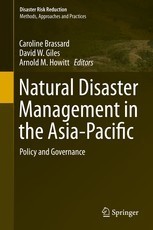Caroline Brassard, David W. Giles, and Arnold M. Howitt, eds., 2015,
ISBN: 978-4-431-55156-0,
203 pages, $129 (hardcover)
Springer
Book review by Thomas W. Haase

The book Natural Disaster Management in the Asia-Pacific presents a synopsis of contemporary risk-management thinking in the Asia-Pacific. The opening chapter, written by editors Caroline Brassard, Arnold Howitt, and David Giles, sets forth the book’s primary thesis: disaster-risk reduction must be integrated into the long-term policy agendas of governments throughout the Asia-Pacific region. To set the context for the subsequent chapters, the editors summarize the lessons of recent disaster experiences and stress that successful disaster risk- management strategies are those that coordinate local, national, regional, and international actors.
The remainder of the book is organized into three parts. Part one reviews how relationships between local and national governments, civil society organizations, and international contributors can improve emergency response and humanitarian relief. In chapter two, for instance, Rebecca Barber details how the Philippines strengthened its disaster-response and relief capacities by adopting a comprehensive framework, clarifying agency responsibilities, and implementing the cluster approach . Shifting to the subject of recovery and resilience, the second part considers: “the ways in which the responsibility for recovery is divided among national, provincial, and local governments – and the community-at-large” (p. 7). This division is illustrated in chapter nine, where Kerry O’Neill reveals how the Victorian Bushfire Reconstruction and Recover Authority worked with local stakeholders to develop a framework for reconstruction for the Marysville area, an Australian community devastated by bushfire. The chapters in the final part of the book explore how community preparedness efforts can help mitigate the costs of disaster. The authors of these chapters consider several preparedness alternatives. Gilles Carbonnier, for example, argues in chapter eleven that risk insurance and risk-linked securities, particularly those developed through public-private partnerships, can help Southeast Asian governments to “assert sovereignty and reduce aid dependency” (p. 186).
The value of this compilation of chapters resides in its breadth and diversity of coverage. While works that explore the experiences of multiple counties can be unwieldy, Natural Disaster Management in the Asia-Pacific is well organized, concise and easy to navigate. Moreover, given the priorities outlined by the Sendai Framework for Disaster Risk Reduction, this book will be of interest to those involved in disaster risk-management activities throughout the Asia-Pacific.